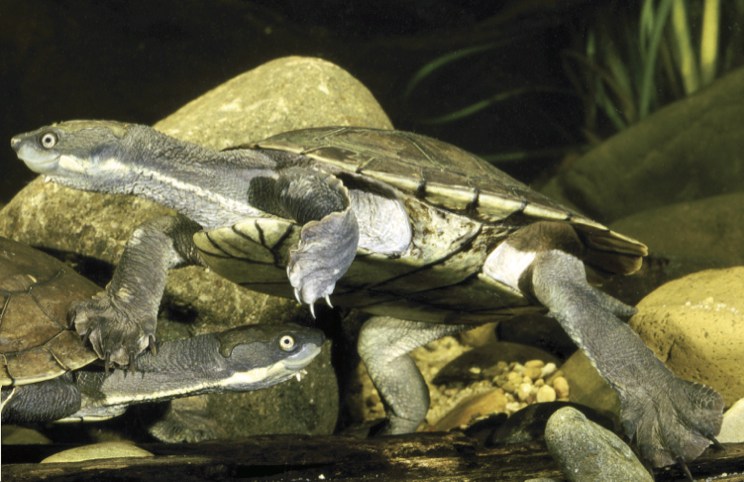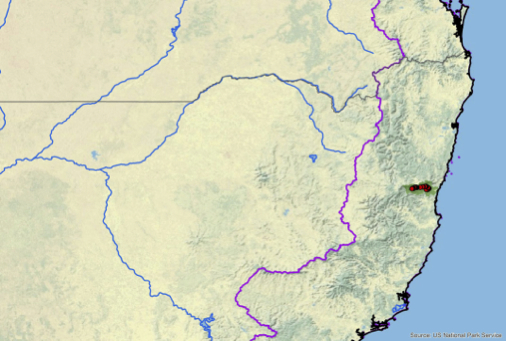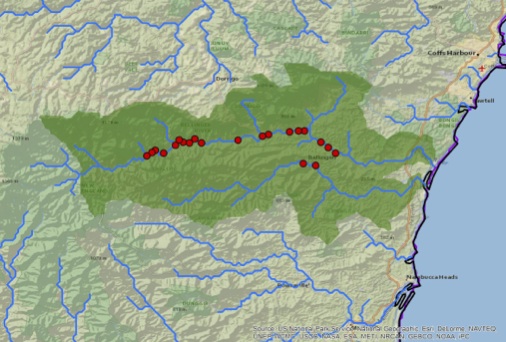Myuchelys georgesi, 091
Myuchelys georgesi (Cann 1997) –
Bellinger River Turtle
John Cann1, Ricky-J. Spencer2, Michael Welsh3, and Arthur Georges4
126 Yarra Road, Phillip Bay, New South Wales 2036, Australia [[email protected]];
2Water and Wildlife Ecology, School of Science and Health, University of Western Sydney, Hawkesbury Campus, Richmond, New South Wales 2753, Australia [[email protected]];
3Australian Department of the Environment, GPO Box 787, Canberra, ACT 2601, Australia
[[email protected]];
4Institute for Applied Ecology, University of Canberra, ACT 2601, Australia
[[email protected]] (corresponding author)
Summary. – The Bellinger River Turtle, Myuchelys georgesi (Family Chelidae), is a turtle of moderate size (carapace length to 240 mm in females, 185 mm in males) with a distribution restricted to the small coastal drainage of Bellinger River in New South Wales, Australia. The species is widely distributed within the drainage basin and has been locally abundant, but with a very restricted range. Its preferred habitat is the deeper pools of the clear-water upstream reaches of the river, where water flows continuously in most months over a bedrock basement and a streambed of boulders, pebbles, and gravel. The species takes advantage of the highly oxygenated water with low particulate load by supplementing its oxygen uptake through cloacal breathing, reducing its obligation to come to the surface to breathe. Myuchelys georgesi is essentially an omnivore, with tendencies leaning toward carnivory. A high proportion of its diet comes from benthic macro-invertebrate communities that are relatively sedentary and live in immediate association with the substratum, but with some terrestrial fruit and aquatic vegetation also eaten. Breeding occurs in the austral spring and early summer. Current threats to its persistence include habitat modification and loss of native riparian vegetation, associated turbidification and sedimentation, predation by the introduced European fox, competition with the recently introduced Emydura macquarii, and a severe recent die-off caused by unknown factors, possibly viral disease, leading to greatly heightened sudden risk of extinction.
Distribution. – Australia. Restricted to the small Bellinger River drainage of northeastern coastal New South Wales.
Synonymy. – Elseya georgesi Cann 1997, Wollumbinia georgesi1, Elseya latisternum georgesi, Myuchelys georgesi.
Subspecies. – None currently recognized.
Status. – IUCN 2015 Red List: Data Deficient (DD, assessed 1996), TFTSG Draft Red List: Critically Endangered (CR, assessed 2015); CITES: Not Listed; Australian EPBC Act: Not Listed; All State and Territory legislation: Not Listed; NSW Threatened Species Conservation Act Draft: Critically Endangered (assessed 2015).
1 Notwithstanding its inclusion in this synonymy, the authors do not consider the name Wollumbinia to be an available name for the reasons outlined in Georges and Thomson (2010).
Citation:
Cann, J., Spencer, R.-J., Welsh, M., and Georges, A. 2015. Myuchelys georgesi (Cann 1997) – Bellinger River Turtle. In: Rhodin, A.G.J., Pritchard, P.C.H., van Dijk, P.P., Saumure, R.A., Buhlmann, K.A., Iverson, J.B., and Mittermeier, R.A. (Eds.). Conservation Biology of Freshwater Turtles and Tortoises: A Compilation Project of the IUCN/SSC Tortoise and Freshwater Turtle Specialist Group. Chelonian Research Monographs 5(8):091.1–9, doi:10.3854/crm.5.091.georgesi.v1.2015, //iucn-tftsg.org/cbftt/.
(Adobe Acrobat 6.0 or later required)

Myuchelys georgesi from the Bellinger River of coastal New South Wales, Australia.
Photo by John Cann.
Distribution:


Distribution of Myuchelys georgesi in eastern Australia (overview and close-up). Purple lines = boundaries delimiting major watersheds (level 3 hydrologic unit compartments – HUCs); red dots = museum and literature occurrence records based on Cann (1998) plus more recent data, and the authors’ personal data; green shading = projected historic native distribution based on GIS-defined level 10 HUCs constructed around verified localities and then adding HUCs that connect known point localities in the same watershed or physiographic region, and similar habitats and elevations as verified HUCs (Buhlmann et al. 2009; TTWG 2014), and adjusted based on authors’ subsequent data.








